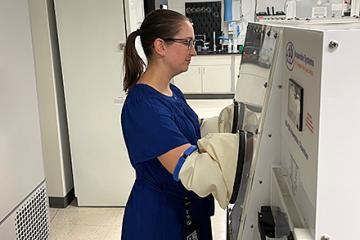Eating Right May be Key to Avoiding Some Diseases

ARS molecular biologist Karley Mahalak uses an anaerobic chamber to grow bacteria. (Photo by Austin Bryant)
Just as the right recipe can make all the difference in the taste of foods on your plate, there is also a perfect combination of ingredients in your stomach that often determines if you’ll feel good or bad.
“Diet plays a major role in the health of the human gut microbiota, which is the microbial community that resides in your gastrointestinal tract and helps with digestion,” said Karley Mahalak, molecular biologist with the Agricultural Research Service’s (ARS) Dairy and Functional Foods Research unit (DFFR) in Wyndmoor, PA. “What you eat can have a major impact on the gut microbiota in terms of community diversity and the products they produce.”
Mahalak is a scientist working on a project that is examining the composition and functionality of the gut microbial community and how “prebiotics” can help. Prebiotics are high-fiber, non-digestible foods that foster growth or activity of beneficial microorganisms in the gastrointestinal tract, particularly in the large intestine. Typically, prebiotics are found in fibrous foods, like whole grains, bananas, and beans.
“Certain members of the gut microbiota can be beneficial to your health, some can be harmful, depending on the amount of them within the gut,” Mahalak said. “The goal of this project is to understand how diet and food processing can change the gut microbiota and its products.”
Mahalak explained that when the gut microbiota breaks down food in the gastrointestinal tract, they create chemicals called metabolites that interact with other members of the gut microbiota, which are absorbed into the cells of the intestinal lining. The body uses these chemicals to protect against adverse health conditions, such inflammatory disease, cardiovascular disease, and diseases associated with the large intestine, such as irritable bowel disease.
One finding that the research team made was that a prebiotic known as fructooligosaccharides (FOS) may be beneficial to people of every age.
“FOS are carbohydrates that are found in many vegetables, such as garlic, onions, and chicory root and are also used frequently in processed foods or as an alternative sweetener,” Mahalak said. “One of our goals was to see whether its beneficial effects are age-dependent.”
For the study, the team collected fecal samples from 18 participants from three different adult age groups: ages 25-35, 36-50, and 51-70. Samples treated with FOS all showed an increase in the population of known beneficial bacteria and increased the production of key metabolites from those bacteria.
“We found that species of bacteria that increased with FOS treatment depended on the age group that was treated, indicating that as the gut microbiota changes with age, functional redundancy becomes key to maintaining a healthy metabolism of prebiotics,” Mahalak said.
Functional redundancy, in this case, means that even though the number of certain species of gut bacteria changes with age, other species can compensate for their loss by contributing properties that offer similarly of function.
The project suggests that the gut microbiota is dynamic and that many factors can influence its health, including diet, hormones, age, and environmental factors such as stress, exercise, and even pollution.
“This study gives further indication that prebiotics can help build and maintain a beneficial gut microbiota [and] that FOS may be able to be used as a prebiotic for all ages,” Mahalak said. “I believe that [further] research like this could help lead to a more personalized approach to diet and dietary components. It may be that certain prebiotics are better suited to particular age groups than others. – by Scott Elliott, ARS Office of Communications
Also in our series on Staying Healthy Later in Life:

